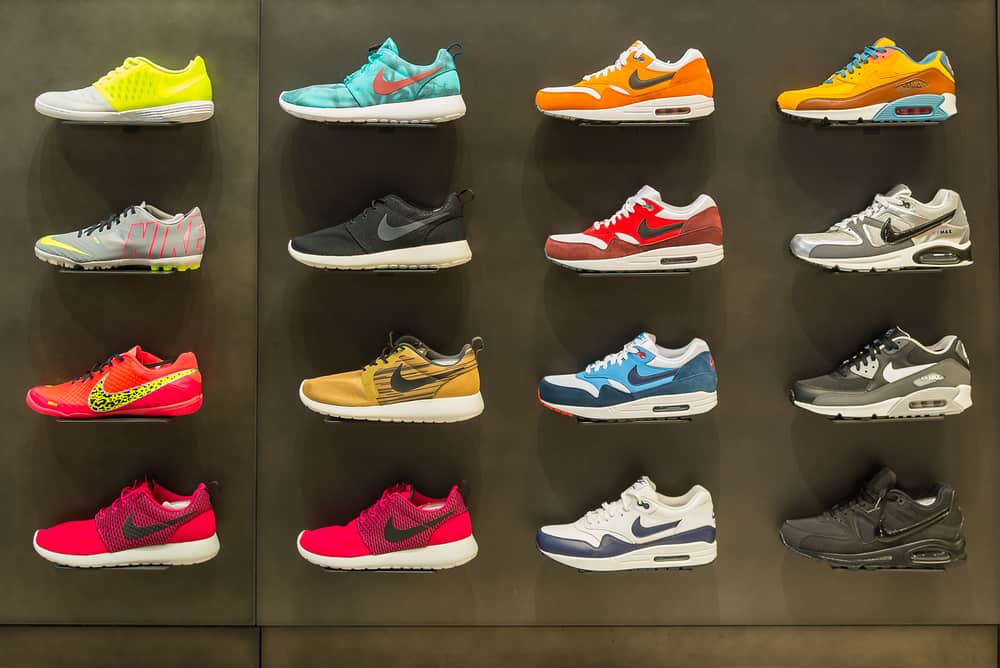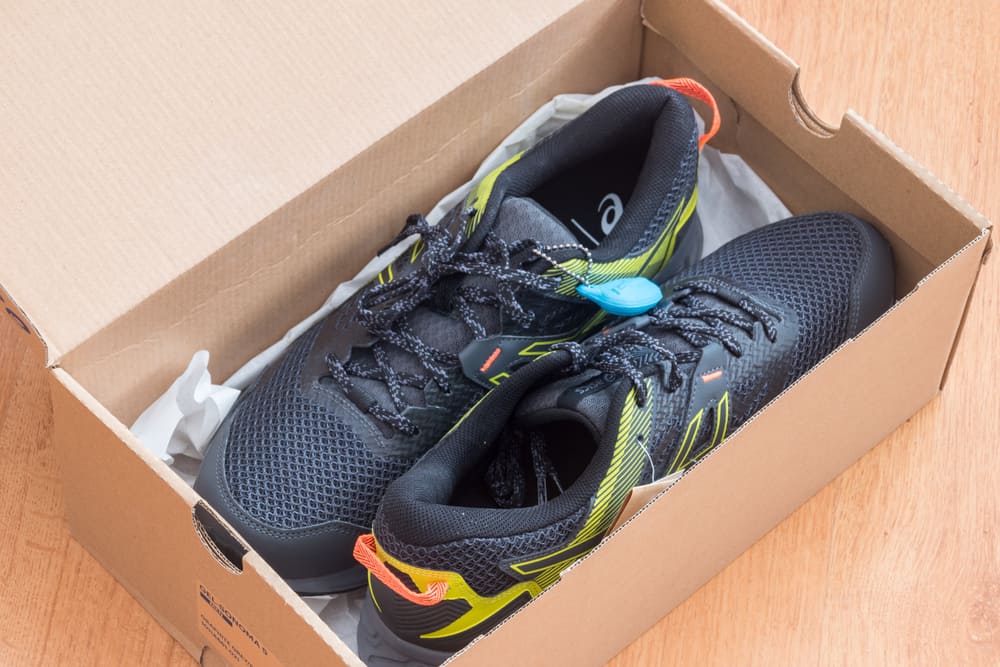When it comes to running, the most important gear is probably your shoes.
They can be the difference between winning and losing or avoiding and sustaining an injury. Your shoes are also responsible for providing enough support, stability, and comfort to boost your running performance.
This is why choosing running shoes is a big deal.
During such a mission, chances are you’ll come across ASICS and Nike. These are two of the biggest names in the industry, but how do they compare to one another?
This is where our article comes in!
Today, we’re sharing a detailed guide on ASICS vs Nike running shoes to help you decide which brand is right for your needs. Let’s get started!
ASICS vs Nike Running Shoes: Materials and Innovation
The best place to begin such a showdown is the materials and technologies that these two companies use in manufacturing their running shoes. This will also help you better understand other aspects of the comparison.
ASICS

This company is all about developing materials from a technological point of view to successfully overcome various obstacles. The following are a few of the main materials that ASICS relies on for the production of its running shoes:
Solyte
Running is a lot more comfortable in lightweight running shoes. To make this happen without sacrificing the functionality of the shoe, ASICS engineered a material called Solyte.
Compared to conventional EVA, Solyte is just half the weight thanks to its foaming properties. It’s a tough yet flexible resin that offers more bounce as well as 20 percent additional shock absorption.
N.C. Rubber
N.C. rubber is a material developed to deliver an improved grip against different surfaces and through various directions for high-performance running. It also offers better durability due to the pairing of traction-enhancing natural rubber with abrasion-resistant synthetic rubber.
SpEVA
SpEVA is a unique blend of rubber ball material and EVA. It combines the best dynamic characteristics of both worlds to boost the rebound of the shoe by an additional 20 percent.
This way, you can perform better as a runner since the energy of every impact you make on the ground is effectively transferred to your next step.
AHAR and AHARPLUS
These materials are featured on the outer soles of ASICS running shoes. They’re made of rubber with a reinforcing agent.
AHAR and AHARPLUS offer remarkable resistance to abrasion (2 and 3 times more than traditional rubber), which means better durability for long-term use. They’re also engineered in sponge form to ensure sufficient cushioning and good grip.
Snow Compound Rubber
Imagine running on a frozen or snowy track — we know, it’s not the safest or most doable thing because of how slippery such roads can be. Even walking on them is a challenge.
This is exactly where the Snow Compound rubber comes in.
Featured in the sole of the shoes, this rubber is made softer with a larger contact area so it’s less prone to hardening when exposed to low temperatures. The result is a stronger grip on the ground when it’s snowy or frozen for safer, slip-free walking and running.
ICEWALK Rubber
The problem with walking or running on icy tracks is that the surface of the road will have a layer of water. This makes it extremely slippery.
ASICS came up with ICEWALK rubber to provide a strong grip in these particular conditions.
The credit here goes to the silica sand blended into the rubber. It acts as spikes that penetrate the water layer on the surface of an icy ground, making it easier and safer to walk or run.
Not to mention, the rubber is also less prone to hardening in the cold, delivering a better grip.
Nike

When it comes to developing and using materials, sustainability and functionality are the main themes for this company. The following are a few of the main materials that Nike relies on for the production of its running shoes:
Nike Flyknit
This material is an especially lightweight fabric. Developed with precision, Nike Flyknit produces 50 percent less waste than other conventional materials used to make uppers for footwear.
Impressively, each running shoe with a Flyknit upper is equivalent to 6 or 7 plastic bottles.
This material is also durable thanks to its high-strength fibers. The stands are stretchy to allow for delivering support to target areas while improving overall flexibility and breathability.
Nike Flyleather
This performance material possesses the appearance, texture, and odor of leather. However, it’s produced using at least 50 percent recycled leather fiber along with synthetic fibers via a manufacturing process powered by water.
Since the used leather scrap was supposed to end up in the landfill, the impact of Nike Flyleather on the environment and the climate is lower than full-grain leather.
Additionally, the new material is more abrasion-resistant and 40 percent more lightweight than true leather.
Nike Air
Nike Air is a signature technology you can find in most soles on the brand’s running shoes. This technology features pressurized air introduced inside a resilient bag.
The purpose of Nike Air is to produce rough soles with enhanced flexibility and bounce. The company wanted a sole that can hold its structure and provide good elasticity while keeping the shoe lightweight.
The cushioning of Nike Air absorbs impact and instantly regains its shape for extra protection and support.
Recycled Polyester
Sticking to its mission of sustainability, Nike uses recycled polyester when manufacturing its fabrics and materials. The company’s recycled polyester is produced out of plastic bottles that undergo:
- Cleaning and bleaching.
- Shredding into flakes.
- Conversion into pellets.
- Spinning into yarn.
Every year, recycled polyester clears up an average of 1 billion plastic bottles.
Sustainable Cotton
Nike has been using recycled, organic, or Better (via the BCI (Better Cotton Initiative)) cotton in 100 percent of its products, including running shoes.
Recycled Nylon
Through a mechanical or chemical recycling process, Nike produces recycled nylon from a wide variety of materials such as used fish nets and carpets. This reduces the company’s carbon footprint by up to 50 percent.
ASICS vs Nike Running Shoes: Shoe Design
Now, let’s move on to the design of the ASICS vs Nike running shoes.
1. Outsole
First, we’re taking a look at the outsoles of the two brands’ running shoes.
In ASICS shoes, the following features are present:
- A deep groove that extends from the heel to the toe for seamless transition and stability.
- Made using either AHAR or AHARPLUS materials.
In Nike shoes, you’ll find the following features:
- Made using carbon rubber.
- Has flex grooves for a natural flow of movement.
2. Midsole
Next, we’ll examine the midsoles of the running shoes.
In ASICS shoes, the following features are present:
- Gel pockets are located in the heel and forefoot for shock absorption.
- A foam layer (FlyteFoam) to boost energy return with each step.
- Reinforced plates to prevent shoe twisting.
In Nike shoes, you’ll find the following features:
- Nike’s signature Air technology.
- The Nike React foam for reducing the incidence of injuries.
- Zoom pods in the heel and forefoot for shock absorption.
- A carbon fiber plate that significantly enhances energy return.
3. Upper
The upper in ASICS running shoes feature the following:
- Mesh or a combination of mesh and another synthetic material.
- A soft feel as if you’re wearing a sock.
- FluidFit technology for improved responsiveness.
- Perforations to allow for adequate air circulation.
The upper in Nike running shoes feature the following:
- Mesh and Nike Flyknit.
- Flywire technology to reinforce the midsole cage.
- More perforation for better ventilation.
4. Cushioning
As for the cushioning, both ASICS and Nike do a great job. They provide ample cushioning that conforms to the contours of your feet.
Both companies offer a wide variety of models where the padding ranges from plush to soft to firm. The choice ultimately comes down to the type of cushioning you feel most comfortable in.
ASICS vs Nike Running Shoes: Size and Fit

One of the most crucial aspects of running shoes is their sizing and the way they fit.
Generally, runners need a snug fit that’s not too tight or too loose. This is why it’s important to assess the sizes offered by ASICS and Nike as two of the biggest names in the industry.
First of all, it’s safe to say that both brands have comparable sizing. The differences aren’t many or too major, summed up in the two following points:
- ASICS features more models that focus on people with wide feet.
- Nike shoes are on the narrower side with some models running a bit small.
ASICS vs Nike Running Shoes: Comfort
When it comes to comfort, we can’t decide the winner since it ultimately depends on the type of support and cushioning you prefer while running.
In ASICS shoes, you’ll find the following comfort elements:
- A roomy toe-box.
- Gel cushioning.
- A responsive yet snug midfoot.
- A heel lock to prevent your foot from twisting.
In Nike shoes, you’ll find the following comfort elements:
- A snug upper.
- High responsiveness thanks to the Dynamic Fit technology.
- Nike React foam for reducing injuries.
- Zoom pods for absorbing impact
ASICS vs Nike Running Shoes: Durability
Once again, judging the durability of ASICS vs Nike running shoes isn’t a simple thing to do because it depends on several factors such as:
- The type of running.
- The frequency of running.
- The distance covered each run.
- The type of terrain.
- The environmental conditions.
- The use of shoes in activities other than running.
- The model of the shoe.
Luckily, both ASICS and Nike are known to produce durable and generally long-lasting running shoes.
ASICS vs Nike Running Shoes: Price
Both ASICS and Nike price their running shoes in the moderate to very expensive tiers. They do, however, keep their prices in line with the average of the industry.
That said, you’ll probably notice that ASICS running shoes usually cost a bit less than Nike running shoes in the same category.
This is why budget-conscious runners tend to prefer ASICS to Nike.
Wrap Up — Which Running Shoes Should You Choose?
There you have it, an in-depth comparison of ASICS vs Nike running shoes. As you can tell by now, the only person who can decide which brand you should go for is you.
Consider the type of arches you have, the level of support you need, the sort of cushioning you’re most comfortable in, and -of course- your budget before you make up your mind.

